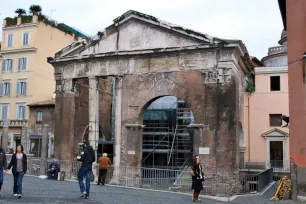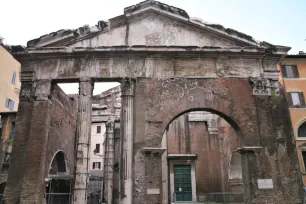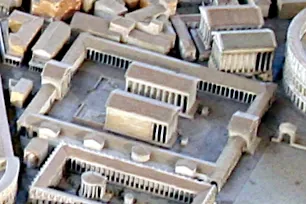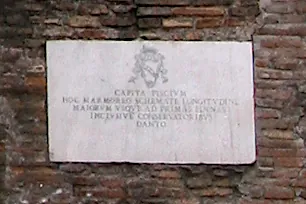The Porticus of Octavia was a large colonnaded courtyard situated between the Theater of Marcellus and the Theater of Balbus. It was originally built in 146 BC and enclosed two temples.


The Porticus of Octavia – or Porticus Octaviae, as it was known during the antiquity – was one of several such structures in the area, including those of Octavianus and Philippus, but no traces of these remain.
Not that there’s much left of the Porticus of Octavia: only a ruined entrance gate is now visible, and a scant five columns are all that remain of the more than three hundred columns that once stood here.
History
A first porticus, the Porticus Metelli, was built here by Quintus Metellus Macedonicus – an army commander who conquered Macedonia – in 148 to 146 BC. Emperor Augustus rebuilt the porticus in 33 to 23 BC and dedicated it to his sister Octavia. In the early third century it was renovated by Septimius Severus and his son Caracalla.
The Porticus

The Porticus of Octavia covered an area of about 135 meters long and 115 meters wide. The whole structure rested on a podium and was surrounded by a double colonnade. Two propylaea (gateways) with Corinthian columns gave entrance to the porticus. A curia (meeting hall) and library were integrated into the colonnades.

At the center were two temples: the Temple of Juno Regina and the Temple of Jupiter Stator. The Temple of Jupiter Stator was the first marble temple in Rome and was built by Metellus in 146 BC. It was designed by the Greek architect Hermodorus of Salamis. Right beside the Temple of Jupiter stood the Temple of Juno, which possibly dated back to the time of Metellus as well.
The porticus was embellished with numerous statues and paintings. Many of the statues were spoils of war from military campaigns in Greece and Macedonia, including a bronze equestrian statue of Alexander the Great, created by the Greek sculptor Lysippus of Sicyon.
Fish Market

During the Middle Ages, the ruins of the Porticus of Octavia were used as a fish market. A marble placard, still clearly visible, has a Latin inscription that states that the heads of the fish larger than the placard, were to be handed over to the city council (the fish head was a delicacy used to make fish soup). In the eighth century, the church of Sant’Angelo in Pescheria was built here on the ruins of the porticus. The church’s name (Pescheria) is a reference to the fish market.

